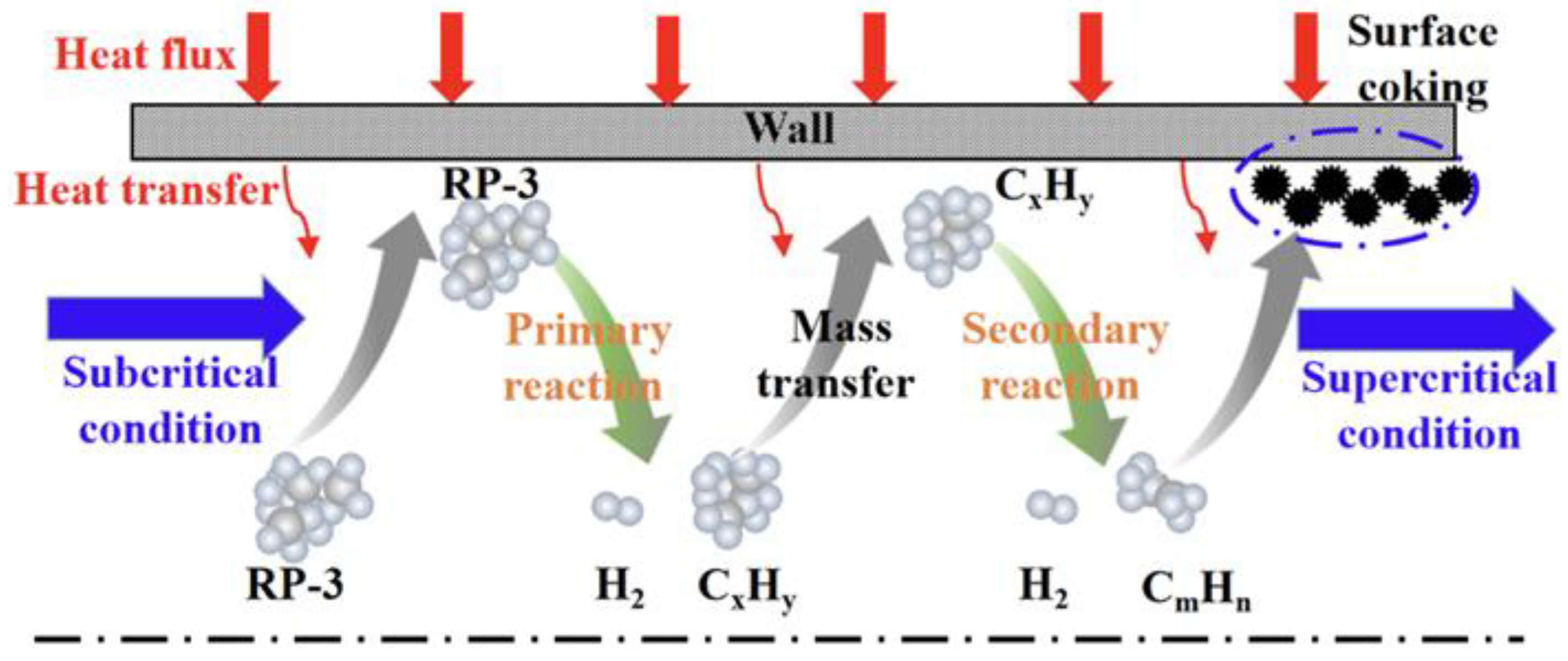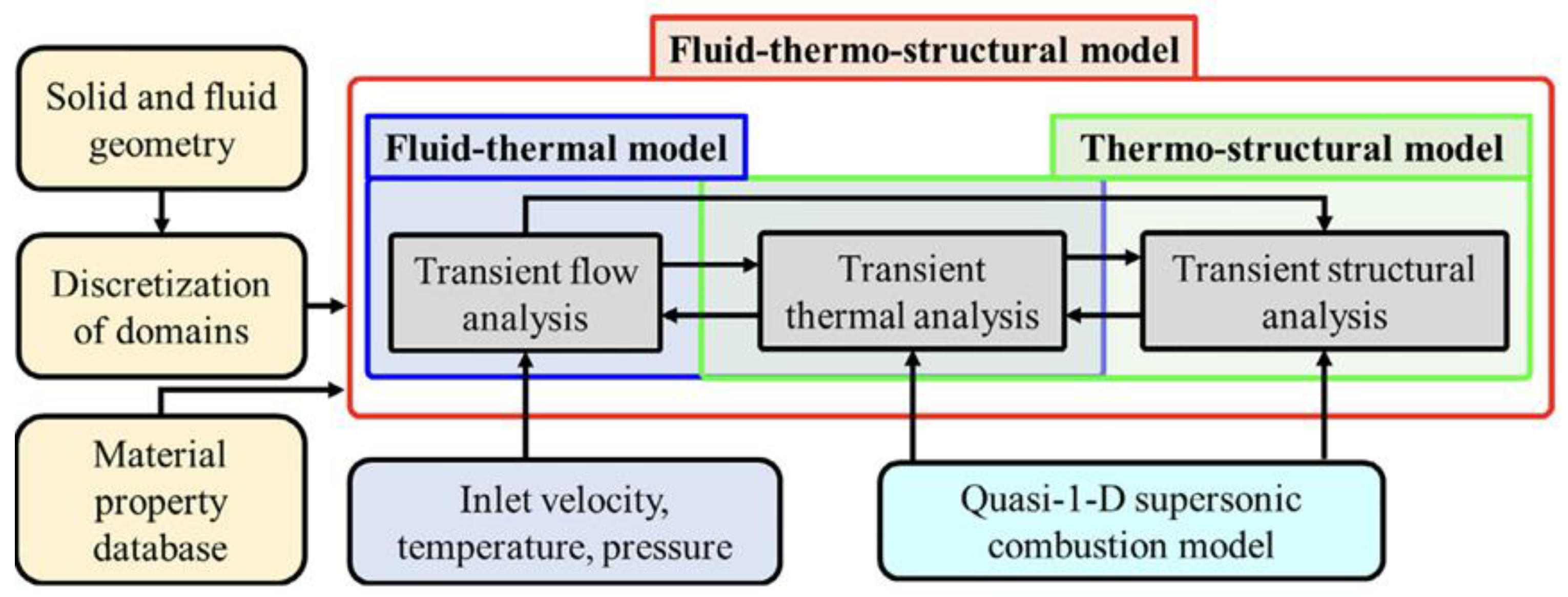Progress of Coupled Heat Transfer Mechanisms of Regenerative Cooling System in a Scramjet
Abstract
:1. Introduction
2. Necessity of Coupled Heat Transfer Analysis in Regenerative Cooling
- (1)
- Fuel in the cooling channel operates in supercritical conditions, mainly to avoid heat transfer deterioration due to phase change, which may lead to the failure of the thermal protection system;
- (2)
- After exceeding the pyrolysis temperature, the endothermic hydrocarbon fuel will produce a pyrolysis reaction to form a mixture of small molecule gases, providing an additional chemical heat-sink;
- (3)
- Fuel composition and physical properties change dramatically during cooling due to the combined action of endothermic and cracking reactions;
- (4)
- Coking may occur during the endothermic pyrolysis of fuel, and the formation of coking deposits will lead to heat transfer deterioration and even channel blockage;
- (5)
- The change in fuel composition will also affect its combustion performance; in addition, the thermal environment of the combustor wall is determined by the combustion performance and cooling efficiency.
3. Research Progress of Regenerative Cooling Coupled Heat Transfer in Scramjet
3.1. Pyrolysis Heat Transfer Coupling in the Cooling Channel
3.2. Combustion and Heat Transfer Coupling in the Combustion Chamber
3.3. Conjugate Thermal Analysis Considering Aerodynamic Heating
4. Conclusions
- (1)
- Pyrolysis in the cooling channel is not always conducive to heat transfer but is related to the heat flux and coking rate. Therefore, it is worthy of further study to regulate the cooling channel layout according to the actual heat flow distribution and suppress coking;
- (2)
- The coupling relationship between combustion and heat transfer in the combustion chamber needs more in-depth research to achieve the optimal collaborative design of cooling performance and thrust performance. On the other hand, apart from calculating the one-way thermal structure response, the two-way coupling of the structure after thermal deformation and the flow field also needs to be explored;
- (3)
- Further validating and improving the accuracy of the conjugate thermal analysis model and using it to evaluate the performance of various thermal protection systems can significantly save test and time costs.
Author Contributions
Funding
Data Availability Statement
Conflicts of Interest
References
- Fry, R.S. A century of ramjet propulsion technology evolution. J. Propul. Power 2004, 20, 27–58. [Google Scholar] [CrossRef]
- Mosavat, M.; Moradi, R.; Barzegar, M. The influence of coolant jet direction on heat reduction on the nose cone with Aerodome at supersonic flow. J. Acta Astronaut. 2018, 6, 26. [Google Scholar]
- Curran, E.T. Scramjet engines: The first forty years. J. Propul. Power 2001, 17, 1138–1148. [Google Scholar] [CrossRef]
- Barzegar, M.; Amini, Y.; Fallah, K. The flow feature of transverse hydrogen jet in presence of micro air jets in supersonic flow. J. Adv. Space Res. 2016, 11, 40. [Google Scholar]
- Song, K.D.; Choi, S.H.; Scotti, S.J. Transpiration cooling experiment for scramjet engine combustion chamber by high heat fluxes. J. Propul. Power 2006, 22, 96–102. [Google Scholar] [CrossRef]
- Hank, J.; Murphy, A.; Mutzman, R. The X-51A scramjet engine flight demonstration program. In Proceedings of the AIAA International Space Planes & Hypersonic Systems & Technologies Conference, Dayton, OH, USA, 28 April–1 May 2008. [Google Scholar]
- Gascoin, N.; Abraham, G.; Gillard, P. Thermal and hydraulic effects of coke deposit in the hydrocarbon pyrolysis process. J. Thermophys. Heat Transf. 2012, 26, 57–65. [Google Scholar] [CrossRef]
- Miao, H.Y.; Wang, Z.W.; Niu, Y.B. Performance Analysis of Cooling System Based on Improved Supercritical CO2 Brayton Cycle for Scramjet. J. Appl. Therm. Eng. 2019, 19, 114774. [Google Scholar] [CrossRef]
- Zhao, Y.; Wang, Y.; Liang, C. Heat transfer analysis of n-decane with variable heat flux distributions in a mini-channel. Appl. Therm. Eng. 2018, 144, 695–701. [Google Scholar] [CrossRef]
- Han, D.B.; Kim, J.S.; Kim, K.H. Conjugate thermal analysis of X-51A-like aircraft with regenerative cooling channels. Aerosp. Sci. Technol. 2022, 126, 107614. [Google Scholar] [CrossRef]
- Tian, K.; Yang, P.; Tang, Z.C. Effect of pyrolytic reaction of supercritical aviation kerosene RP-3 on heat and mass transfer in the near-wall region. Appl. Therm. Eng. 2021, 197, 117401. [Google Scholar] [CrossRef]
- Feng, T.; Qin, J.; Zhang, S.L. Modeling and analysis of heat and mass transfers of a supercritical hydrocarbon fuel with pyrolysis in mini-channel. J. Heat Transfer 2015, 91, 520–531. [Google Scholar] [CrossRef]
- Feng, T.; Zhang, S.L.; Cao, J. Coupling relationship analysis between flow and pyrolysis reaction of endothermic hydrocarbon fuel given characteristic time correlation in mini-channel. Appl. Therm. Eng. 2016, 16, 30486. [Google Scholar]
- Jiang, Y.G.; Qin, J.; Chetehouna, K. Effect of geometry parameters on the hydrocarbon fuel flow rate distribution in pyrolysis zone of SCRamjet cooling channels. J. Heat Transf. 2019, 141, 1114–1130. [Google Scholar] [CrossRef]
- Lei, Z.L.; He, K.; Huang, Q. Numerical study on supercritical heat transfer of n-decane during pyrolysis in rectangular tubes. Appl. Therm. Eng. 2020, 170, 115002. [Google Scholar] [CrossRef]
- Tian, K.; Tang, Z.C.; Wang, J. Simplified pyrolytic model of RP-3 fuel at high conversion rates and the effects of primary reaction on the regenerative cooling process. Aerosp. Sci. Technol. 2022, 129, 107853. [Google Scholar] [CrossRef]
- Li, Z.Z.; Li, Y.; Zhang, X.W. Coupling of pyrolysis and heat transfer of supercritical hydrocarbon fuel in rectangular minichannels. Chem. Eng. Sci. 2022, 247, 116924. [Google Scholar] [CrossRef]
- Li, Z.Z.; Liu, G.Z.; Zhang, R.L. Heat transfer to supercritical hydrocarbon fuel in horizontal tube: Effects of near-wall pyrolysis at high heat flux. Chem. Eng. Sci. 2021, 229, 115994. [Google Scholar] [CrossRef]
- Gong, K.Y.; Cao, Y.; Feng, Y. Influence of secondary reactions on heat transfer process during pyrolysis of hydrocarbon fuel under supercritical conditions. Appl. Therm. Eng. 2019, 159, 113912. [Google Scholar] [CrossRef]
- Jiao, S.; Li, S.F.; Pu, H. Experimental investigation on thermal cracking and convective heat transfer characteristics of aviation kerosene RP-3 in a vertical tube under supercritical pressures. J. Therm. Sci. 2019, 146, 106092. [Google Scholar] [CrossRef]
- Jiao, S.; Li, S.F.; Pu, H. Investigation of pyrolysis effect on convective heat transfer characteristics of supercritical aviation kerosene. Acta Astronaut. 2020, 171, 55–68. [Google Scholar] [CrossRef]
- Li, Y.; Wang, J.B.; Xie, G.N. Effect of thermal pyrolysis on heat transfer and upward flow characteristics in a rectangular channel using endothermic hydrocarbon fuel. Chem. Eng. Sci. 2021, 244, 116806. [Google Scholar] [CrossRef]
- Wang, R.T.; Zhao, J.J.; Bao, Z.W. Thermal cracking and coke deposition characteristics of aviation kerosene RP-3 in an S-bend tube. Fuel 2022, 313, 122673. [Google Scholar] [CrossRef]
- Zhang, C.; Gao, H.; Zhao, J.J. Dynamic coking simulation of supercritical n-decane in circular tubes. Fuel 2023, 331, 125859. [Google Scholar] [CrossRef]
- Zhang, C.; Qin, J.; Yang, Q.C. Design and heat transfer characteristics analysis of combined active and passive thermal protection system for hydrogen-fueled scramjet. Int. J. Hydrogen Energy 2015, 40, 675–682. [Google Scholar] [CrossRef]
- Taddeo, L.; Gascoin, N.; Chetehouna, K. Experimental study of pyrolysis-combustion coupling in a regeneratively cooled combustor: Heat transfer and coke formation. Fuel 2019, 239, 1091–1101. [Google Scholar] [CrossRef]
- Gopinath, N.K.; Govindarajan, K.V.; Mahapatra, D.R. Fluid-thermo-structural response of actively cooled scramjet combustor in hypersonic accelerating-cruise flight. J. Heat Transf. 2022, 194, 123060. [Google Scholar] [CrossRef]
- Zhang, T.; Jing, T.T.; Qin, J. Topology optimization of the regenerative cooling channel in the non-uniform thermal environment of hypersonic engineopology optimization of regenerative cooli thermal environment of the hypersonic engine. Appl. Therm. Eng. 2023, 219, 119384. [Google Scholar] [CrossRef]





Disclaimer/Publisher’s Note: The statements, opinions and data contained in all publications are solely those of the individual author(s) and contributor(s) and not of MDPI and/or the editor(s). MDPI and/or the editor(s) disclaim responsibility for any injury to people or property resulting from any ideas, methods, instructions or products referred to in the content. |
© 2023 by the authors. Licensee MDPI, Basel, Switzerland. This article is an open access article distributed under the terms and conditions of the Creative Commons Attribution (CC BY) license (https://creativecommons.org/licenses/by/4.0/).
Share and Cite
He, N.; Liu, C.; Pan, Y.; Liu, J. Progress of Coupled Heat Transfer Mechanisms of Regenerative Cooling System in a Scramjet. Energies 2023, 16, 1025. https://doi.org/10.3390/en16031025
He N, Liu C, Pan Y, Liu J. Progress of Coupled Heat Transfer Mechanisms of Regenerative Cooling System in a Scramjet. Energies. 2023; 16(3):1025. https://doi.org/10.3390/en16031025
Chicago/Turabian StyleHe, Ni, Chaoyang Liu, Yu Pan, and Jian Liu. 2023. "Progress of Coupled Heat Transfer Mechanisms of Regenerative Cooling System in a Scramjet" Energies 16, no. 3: 1025. https://doi.org/10.3390/en16031025
APA StyleHe, N., Liu, C., Pan, Y., & Liu, J. (2023). Progress of Coupled Heat Transfer Mechanisms of Regenerative Cooling System in a Scramjet. Energies, 16(3), 1025. https://doi.org/10.3390/en16031025






